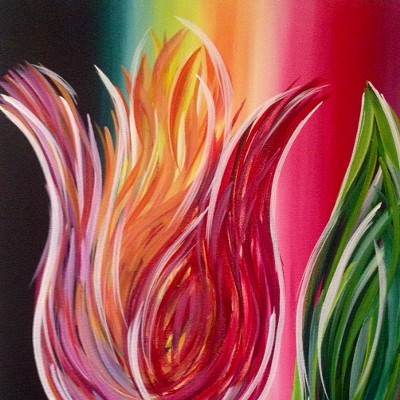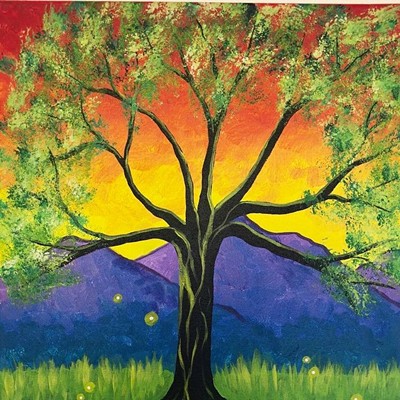Rendered almost photo-realistically, the delicate silks of the exotic shoes glisten in oils on linen, in reds, golds and greens. The embroidered designs spin across the slippers in spirals and tendrils, hemmed in by geometric borders. Brightly lit by studio lights and greatly enlarged, the slippers lend their reflected glory to sumptuous backgrounds in tawny hues. (This Saturday night during the Art Safari season opener for the Central Tucson Gallery Association, the pictures will be on view.)
But there's something rotten in their state of loveliness: These gorgeous objects camouflage the most grisly of practices.
A longtime still-life painter in Tucson, Conaway discovered that exquisite slippers like these--objets d'art, really--were once used to cover up Chinese women's bound feet. For nearly a thousand years, until the fall on the last Qing dynasty in 1911, small Chinese girls had their feet bound nearly in half, with their toes forced under toward the soles. Eventually the toes would break. Not only did the girls suffer terrible pain, they grew into women who could barely walk. Their deformed feet--called "lotus hooks"--were typically just 4 inches long.
Which accounts for the slippers' strange shapes. Instead of being long and horizontal, like normal shoes, they're short and triangular, with just a tiny sliver of a heel. Examining the phenomenon, Conaway has looked at the slippers from every angle, from above, from below, from the side. In "Do se Do," five slippers twirl like a pinwheel. "Well, That's One Way to Get to the Top" has one conquering slipper atop a mound of five others that have been crushed. "Missed Step" has one orange-gold slipper above another.
Conaway isn't shy about saying in an artist's statement that she deplores foot-binding as a "pretty horrible" practice. And her titles directly and her compositions metaphorically tease out the power relationships that put just one sex--the female, natch--through this culturally approved torture. She hastens to add that the metaphor extends to any social group that allows "cultural imperatives" to override "basic humanity." The pretty slippers that conceal ugly deeds could be a stand-in for all kinds of similar cultural imperatives, such as, oh, say, an unwarranted invasion of a foreign land wrapped up in a patriotic flag.
But this painter has long used objects as symbols in her serious still lifes. In the past, vegetables writ large and swathed in shadows have stood in for grief.
A series of 12 small broken-heart paintings are more literal than usual for Conaway, who suffered the tragic death of her grown son several years ago. A heart-shaped pincushion with a tattered ruffle around the edges is painted over and over, one to a painting. A hat pin with a nasty blade has been thrust into the stuffing right about where the heart would be, if the cushion were a human body.
Each tiny heart is a different color, differently shaded, reflecting different moods. "Heart of Stone" is cold, white and gray, with a deep charcoal background. "Hearthrob" may hint at some sign of life rekindling after a period of mourning. Against a rich purple, a pale ray of yellow creeps across the telltale heart.
Conaway's paintings are accompanied by big wood and steel floor sculptures by John Davis, an artist who consistently looks at the conflict between nature and humans, between the earth and development. Machinelike vises and levers clamp tree stumps, which by and large stand very little chance of winning. In the subversive "Adrift," though, the earth seems to have a shot. Twigs are shooting out the sides of a felled cylinder, making their escape.
Davis Dominguez is one of nine galleries that will open their doors during the Art Safari gala openings Saturday night, Feb. 3. Davis Dominguez, at 154 E. Sixth St. in the Warehouse District, will hold a reception from 6 to 8 p.m.; daytime Saturday hours are 10 a.m. to 4 p.m. The Conaway-Davis show continues through Saturday, Feb. 25. 629-9759; davisdominguez.com.
Here's a quick list of other galleries on the tour.
Right next door, The Gallery at 6th & 6th, 439 N. Sixth Ave., is exhibiting the lyrical abstractions of the late Michio Takayama, a painter who worked in Taos, N.M., for 20 years. The reception for his Color and Serenity will be from 6 to 9 p.m. The gallery will also be open 11 a.m. to 4 p.m. 903-0650; sixthandsixth.com.
Next is Platform Gallery, also at 439 N. Sixth Ave. New paintings by Barbara Brandel and Jesse Wood and sculpture by Aaron Kramer are on the menu. The gallery will be open nonstop from 11 a.m. to 9 p.m., with the reception slated for 6 to 9 p.m. 882-3886; platformart.com.
Raices Taller Studio 222 is close by at 222 E. Sixth St. Carnival, a celebratory group show, includes some Mardi Gras photos by Dallas Josephy and a painting of a Native American "Festival Nativo" by Wallace N. Begay. Reception is 6 to 9 p.m.; afternoon hours are 1 to 5 p.m. 881-5335; raicestaller222.org.
A couple of galleries are in the Fourth Avenue shopping district, close to downtown. At The Drawing Studio, 214 N. Fourth Ave., Through the Pinhole will turn the gallery into a giant camera obscura. Visitors can "walk into an actual camera and see life on Fourth Ave. as the camera might see it," according to organizer Kathleen Velo. Reception is 6 to 9 p.m.; afternoon hours are noon to 5 p.m. 620-0847; thedrawingstudio.org.
A flock of metal chickens will be roosting at Conrad Wilde Gallery, 210 N. Fourth Ave. The hens in Lauri Slenning's bronze Fowl Play series will be having a late night, for chickens. Reception is 6 to 9 p.m.; more fowl-friendly afternoon hours are 11 a.m. to 6 p.m. 622-8997; conradwildegallery.com.
A little to the West, Dinnerware Contemporary Arts, 101 W. Sixth St., at Ninth Ave., is focusing on the digital in BYTES: Making Pictures with Ones and Zeroes, a group show of digital work curated by UA photog prof Joseph Labate. Reception is 7 to 9 p.m.; daylight hours are noon to 6 p.m. 792-4503; dinnerwarearts.com.
Down in Barrio Historico, Gallery Centella, 340 S. Convent Ave., continues the group show Yatra: Return to Self, with paintings by Amy Garcia, Aryen Hart and Beth Ames Swartz, and gives a preview of the next exhibition, metal sculptures by Mexico City artist Jorge Marin. Regular Saturday hours are 10 a.m. to 4 p.m. The party's from 6 to 8 p.m. 798-3400; studiocentella.com.
A bit farther south, Philabaum Glass Studio, 711 S. Sixth Ave., is open in the day only, but visitors get to watch Tom Philabaum and his assistants at work in the studio. Master artist Philabaum this year celebrates his 25th anniversary making glass art in Tucson. Hours are 10 a.m. to 4:30 p.m. 884-7404; philabaumglass.com.














